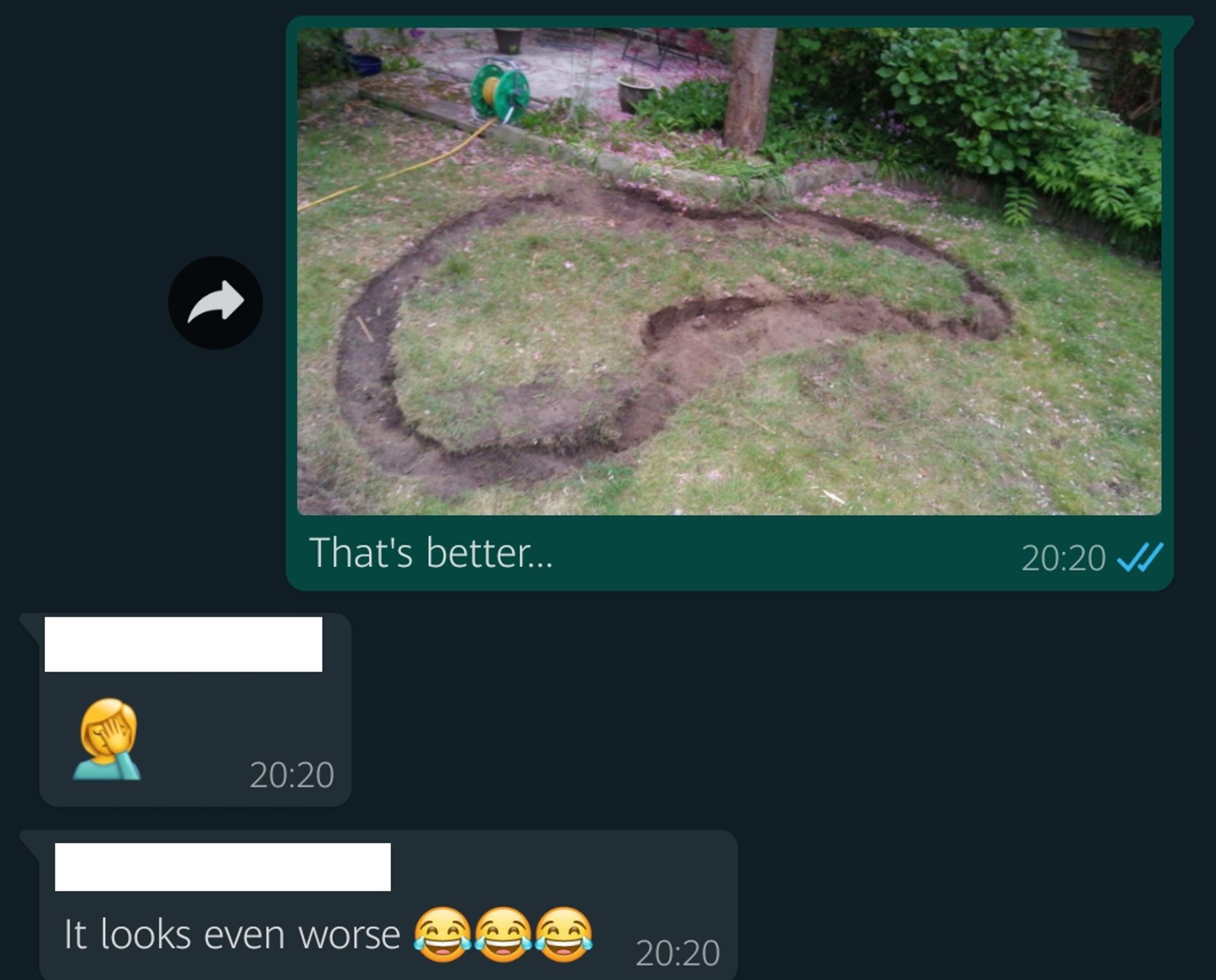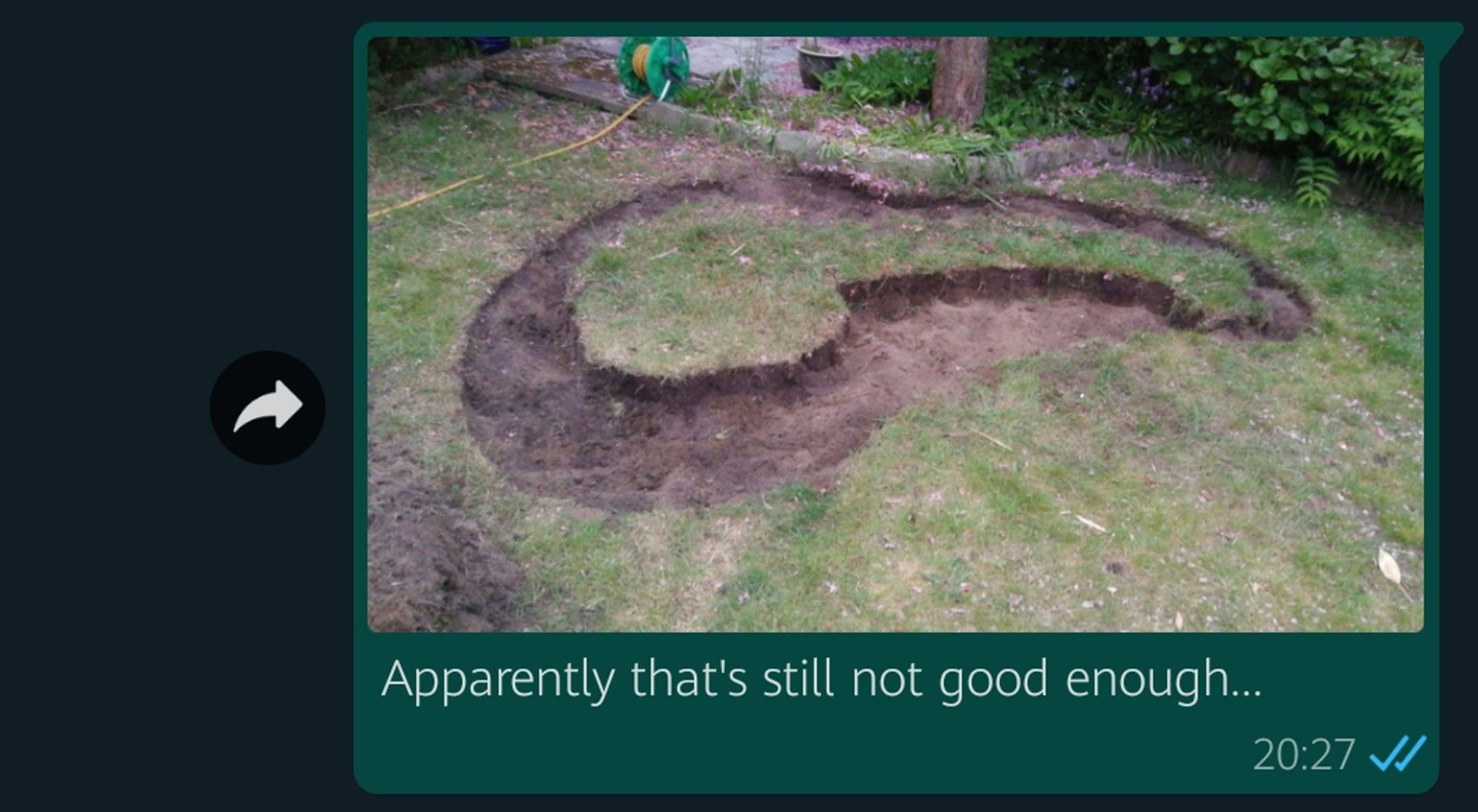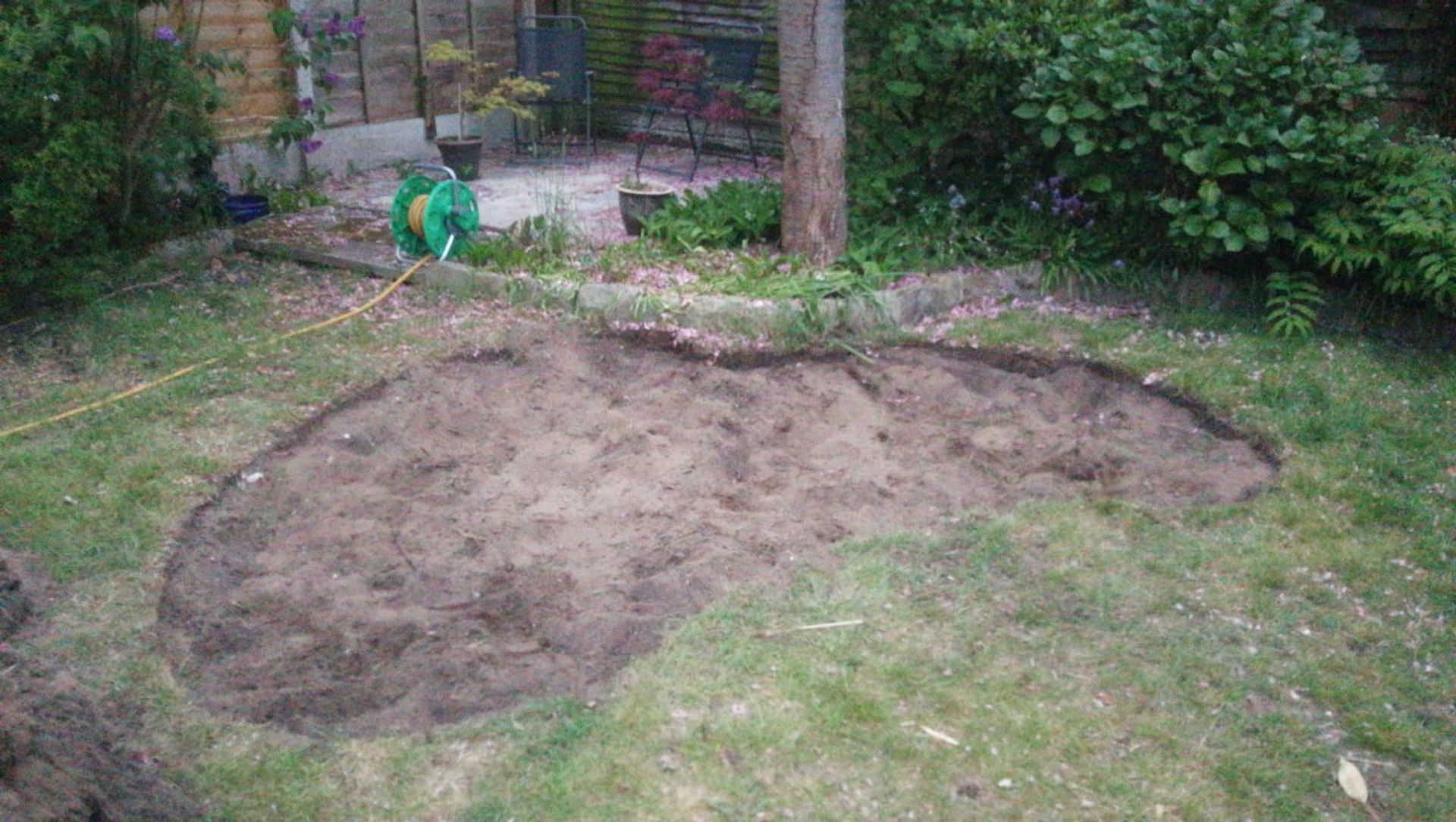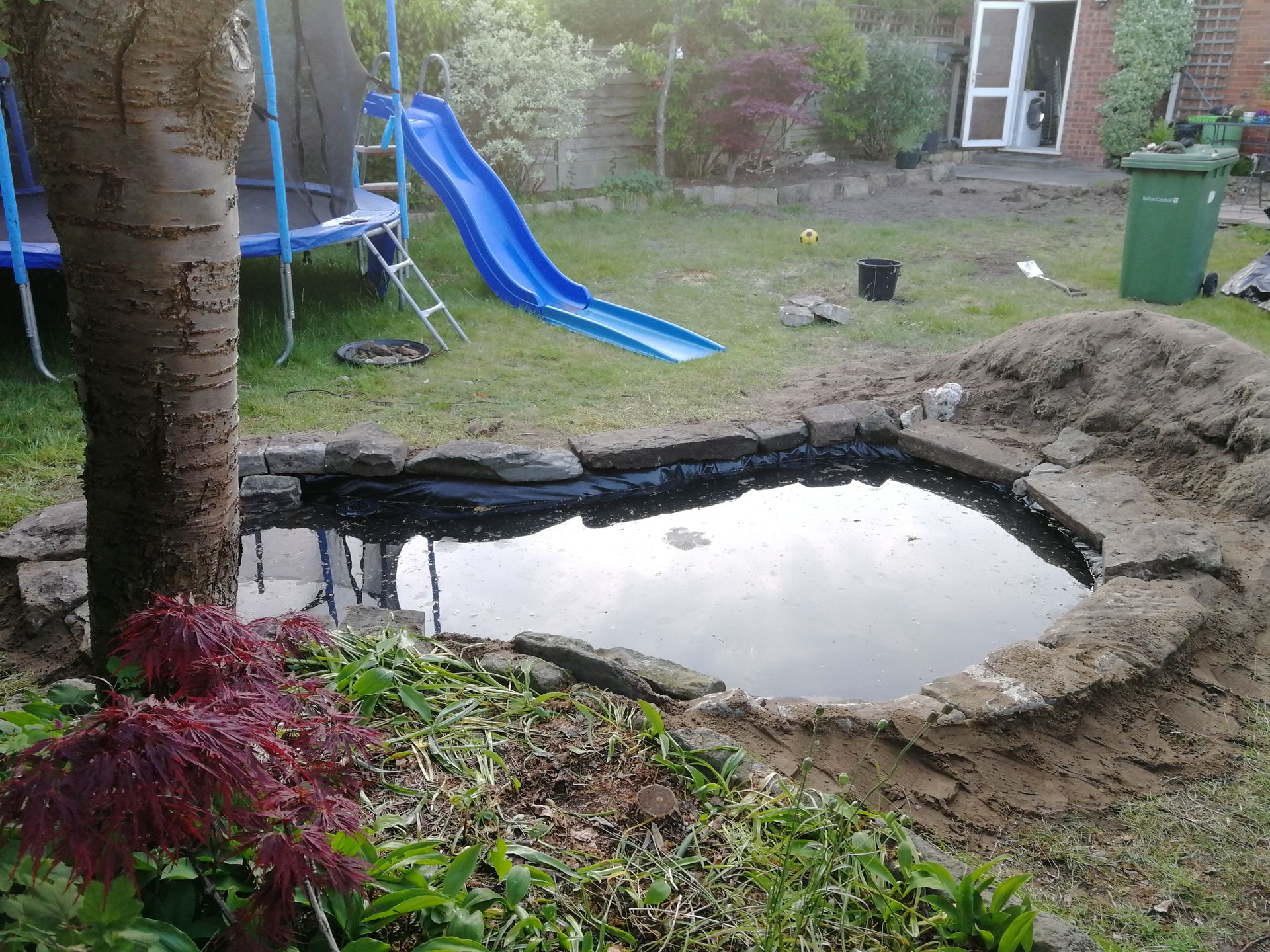I knew I was going to be digging a pond, and I knew roughly where the pond needed to go. Obviously, the first step is to dig a big hole. But how big? How deep should the pond go? What shape should it be? It turns out that there are some really simple guidelines when it comes to digging a pond. I knew that this was going to be a wildlife pond, so I didn't need to worry about fish overwintering in the pond because the fish would eat the wildlife I wanted to attract.
There are tons of useful websites about wildlife ponds out there. Some of the more useful ones (in my opinion) were the Wildlife Trust, the RSPB, and Froglife but google will give you plenty of links to peruse.
The basics are pretty simple, though: dig a hole, put a pond liner in it, and fill it with water. The next level of complication is that you ideally want to build it with stepped shelves so you have different levels of water in there, and that you should have a shallow sloped area in case an animal falls in so that it can climb back out again. Apparently hedgehogs are particularly prone to this, and they're not good swimmers. Aim for it to have a section at least 60cm deep as that'll protect some of the inhabitants from weather extremes. Oh, and try to give it a curved edge as that helps create microhabitats which will attract more wildlife.
Armed with that advice I went online and bought myself a nice big pond liner. I had plenty of stones in the garden that I could use for decorative edging, and I figured that I could use the removed dirt and turf to make a grass mound next to the pond for the kids to lie on. To get the curved shape, my wife and I went out armed with some sticks and made a kidney shape out of them at the bottom of the garden in front of the cherry tree. I removed the turf from the outside shape, and we called it a night as it was time to put the girls to bed. We didn't spot the problem until we showed our eldest daughter from upstairs:

I'm fairly certain that you've spotted the problem. Our daughter certainly did.
My wife made me go outside to fix it immediately, even though it was already eight o'clock at night. Unable to resist sharing, this went onto our family WhatsApp chat in a series of messages that have since been shared with friends and family and work colleagues in what has become the legend of the penis pond.

So I dug around the edges a bit first...
That made it look worse, apparently. I was forced to continue.

Turns out, I can still make it look even worse. Call it a talent.
My argument that the wildlife wouldn't care about the shape was overruled because my wife did, and felt the neighbours might also object. I cleared away the turf from the centre, and was finally left with the intended kidney-shaped pond we were after all along.

If that still looks like a penis to you, go and talk to your mother
That was enough for the night, but over the next few days I dug the pond out. I should explain a little about the soil here though - or more accurately, about the fact that it isn't soil at all. It's sand. The top couple of inches is black sand, but it rapidly becomes normal sand underneath that. The thing about sand (as anyone who has tried digging a hole on a beach knows) is that it has a tendency to collapse. What I'd basically started to do was to dig a very big hole in something that wanted to collapse. That bit about needing to have a gentle slope? Yeah, the whole damn pond was one gentle slope becase it all just sloped into the middle. To dig down to the required depth meant digging outward first to make sure it didn't collapse and fill the hold in immediately. At least it meant I wouldn't need to worry about lining the hole with fleece or anything, though. Small mercies.
To say that was a frustrating experience for me would be an understatement. To say that my darling wife found it thoroughly entertaining is probably a bigger understatement. Trying to get stepped levels was an exercise in frustration, but eventually I had something that had some levels at the top where the soil held together and a shallow slope on one edge, and some deeper bits in the middle. I put the pond liner in, and started adding some water to it.

Yes, I overbought on the liner
As the water went in, I folded the liner up to try to keep things neat and tidy, and to keep it as taut as possible. I kept doing that until the liner filled up, and then over the next day or two I used some of the stones I'd recovered from elsewhere in the garden to edge the pond. These would get tweaked over time while I worked around the pond, but this was a pretty solid start.

Edged with stones to hide the liner, and ready for wildlife
You can see the mound next to the pond that I intended to turn into a turf mound at this point. That didn't end up happening because I realised it would completely block the view of the pond from the seating area. Over the next few months, I'd add some aquatic baskets into the pond with some oxygenating plants, some leafy, reed type plants, and some pond iris to green it up a bit and to give some habitats for the wildlife. In the end, it took less than three months for a frog to find the pond, and the following spring we had masses of spawn and tadpoles, and there's a whole raft of insects living in there. We get damselflies and dragonflies in the garden, too, along with masses of tiny froglets all through the flower beds. We've seen newts in the area, but we don't think we have any in the pond yet, but I think that might be because they might need some different plants in there to lay their eggs on. I need to do a bit more digging on that score.
One other thing I have learned, though, is that putting a pond near to a tree has the downside of collecting all of the leaves from the tree and hugely encouraging duckweed. There are simple remedies - netting above the pond in autumn to minimise it, collecting the leaves regularly off the surface of the pond, or even just netting the duckweed on a regular basis. It can be a pain to have to rescue the tadpoles out of the net, but it's also quite good fun to see what's in the pond and how many there are in there so I don't mind too much. You'll never stop every leaf getting into the pond, though, but perhaps a little more distance might have been sensible.
Published
Last Post: Taking shape - but what shape?
Next Post: Somewhere to sit
How about sharing this article on your favorite social media network if you've found it interesting? For feedback, please get in touch via Twitter or Instagram